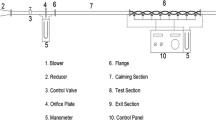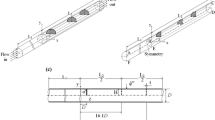Abstract
Flow and heat transfer characteristics in transition and turbulent regions are studied experimentally and numerically in a horizontal smooth regular hexagonal duct under constant wall temperature boundary condition covering a range of Reynolds number from 2.3 × 103 to 52 × 103. Two types of k-omega (standard and shear stress transport (SST)) and three types of k-ε (standard, renormalization (RNG), and realizable) turbulence model are employed for transition and turbulent regions, respectively. Both average and fully developed Darcy friction factor and Nusselt number are presented as a function of Reynolds number. It is seen that k-omega SST and k-ε realizable turbulence models gave the best agreement with the experimental data in transition and turbulent regions, respectively. All the experimental results are correlated within an accuracy of ±13 % and ±7 % for Nusselt number and Darcy friction factor, respectively. Results obtained in this study are compared with circular duct results using hydraulic diameter.











Similar content being viewed by others
Abbreviations
- A c :
-
Cross sectional area of the hexagonal duct (m2)
- A s :
-
Heat transfer surface area of the hexagonal duct (m2)
- c p :
-
Specific heat (kJ kg−1 K−1)
- C 1, C 2 :
- C μ :
-
Constant
- D h :
-
Hydraulic diameter of the hexagonal duct (m)
- \( \dot{E} \) :
-
Total electric power input (W)
- F :
-
Average Darcy friction factor
- f fd :
-
Fully developed Darcy friction factor
- f x :
-
Peripherally averaged local Darcy friction factor
- F :
-
View factor
- h m :
-
Average heat transfer coefficient (W m−2 K−1)
- k :
-
Turbulent kinetic energy (m2 s−2)
- k c :
-
Thermal conductivity (W m−1 K−1)
- l :
-
Turbulence length scale (m)
- L :
-
Axial length of the hexagonal duct (m)
- \( \dot{m} \) :
-
Mass flow rate of the airflow through the hexagonal duct (kg s−1)
- n 1, n 2 :
- Nu fd :
-
Fully developed Nusselt number
- Nu m :
-
Average Nusselt number
- Nu x :
-
Peripherally averaged Nusselt number
- P :
-
Wetted perimeter of the hexagonal duct (m)
- Pr :
-
Prandtl number
- Δp :
-
Axial pressure drop across the hexagonal duct (Pa)
- q w,x′′:
-
Peripherally averaged wall heat flux at x-position (W m−2)
- \( \dot{Q}_{c} \) :
-
Steady-state forced convection heat transfer from the hexagonal duct to the airflow (W)
- \( \dot{Q}_{l} \) :
-
Conduction heat loss from the hexagonal duct assembly to the surroundings (W)
- \( \dot{Q}_{r} \) :
-
Radiation heat loss from ends of the hexagonal duct to the surroundings (W)
- Re :
-
Reynolds number
- T :
-
Temperature (K)
- T b :
-
Bulk mean temperature (K)
- T bi, T bo :
-
Mean temperatures of the airflow at the inlet and outlet (K)
- T i :
-
Inlet temperature (K)
- T w :
-
Wall temperature of the hexagonal duct (K)
- T ∞ :
-
Ambient temperature (K)
- u i :
-
Velocity component in the i direction (m s−1)
- u j :
-
Velocity component in the j direction (m s−1)
- \( \left( { - \overline{{u_{\text{j}}^{\prime } T^{\prime } }} } \right) \) :
-
Turbulent heat flux (m s−1 K)
- \( \left( { - \overline{{u_{\text{i}}^{\prime } u_{\text{j}}^{\prime } }} } \right) \) :
-
Turbulent shear stress (m2 s−2)
- u, v, w :
-
Velocity components (m s−1)
- U :
-
Mean air velocity in the hexagonal duct (m s−1)
- U(x):
-
Mean velocity at x-position (m s−1)
- x, y, z :
-
Cartesian coordinates (m)
- x i :
-
Coordinate in the i direction (m)
- x j :
-
Coordinate in the j direction (m)
- y p :
-
Distance of the centroid of the nearest cell from the wall (m)
- y + :
-
Dimensionless distance from wall
- Θ :
-
Dimensionless temperature
- ε :
-
Turbulent dissipation rate (m2 s−3)
- ε e :
-
Surface emissivity
- τ w :
-
Wall shear stress (Pa)
- τ w,x :
-
Peripherally averaged wall shear stress at x-position (Pa)
- ρ :
-
Fluid density (kg m−3)
- σ :
-
Stefan-Boltzmann constant (W m−2 K−4)
- υ :
-
Kinematic viscosity of the airflow (m2 s−1)
- ω :
-
Specific dissipation rate (s−1)
References
He S, Gotts JA (2004) Calculation of friction coefficients for noncircular channels. ASME J Fluids Eng 126:1033–1038
Kakaç S, Shah RK, Aung W (1987) Handbook of single-phase convective heat transfer. Wiley, USA
Sadasivam R, Manglik RM, Jog MA (1999) Fully developed forced convection through trapezoidal and hexagonal ducts. Int J Heat Mass Transf 42:4321–4331
Morini GL (2005) Viscous heating in liquid flows in micro-channels. Int J Heat Mass Transf 48:3637–3647
Shah RK, London AL (1978) Laminar flow forced convection in ducts. Supplement 1 to advances in heat transfer, Academics, New York
Asako Y, Nakamura H, Faghri M (1988) Developing laminar flow and heat transfer in the entrance region of regular polygonal ducts. Int J Heat Mass Transf 31:2590–2593
Damean N, Regtien PPL (2001) Velocity field of the fully developed laminar flow in a hexagonal duct. Sens Actuators, A 92:144–151
Nan S (2001) Prediction of fully developed pressure drops in regular polygonal ducts. ASME J Fluids Eng 123:439–442
Nonino C, Del Giudice S, Savino S (2006) Temperature dependent viscosity effects on laminar forced convection in the entrance region of straight ducts. Int J Heat Mass Transf 49:4469–4481
Wang CY (2011) Forced convection in a polygonal duct with a circular core. J Heat Transf-Trans ASME 133:1–4
White FM (1994) Fluid mechanics, 3rd edn. McGraw Hill, New York
Benedict RP (1977) Fundamentals of temperature, pressure and flow measurements, 2nd edn. Wiley, New York
Holman JP (2001) Experimental methods for engineers, 7th edn, chapter 3, McGraw-Hill, New York
Cengel YA, Ghajar AJ (2011) Heat and mass transfer fundamentals and applications, 4th edn, chapter 8, McGraw Hill, USA
Schlichting H (1987) Boundary layer theory, 7th edn. McGrall Hill, USA, p 597
ANSYS Inc., FLUENT 12.0 User’s guide, 2008, Lebanon, USA
Kakaç S, Liu H (2002) Heat exchangers selection, rating, and thermal design, 2nd edn, chapter 3. CRC Press, USA
Acknowledgments
This work is funded by the Unit of Scientific Research Projects of Gazi University under the project BAP 06/2008-38: Experimental and numerical investigation of heat transfer for hydrodynamically and thermally developing flow in a hexagonal duct under constant wall temperature.
Author information
Authors and Affiliations
Corresponding author
Rights and permissions
About this article
Cite this article
Turgut, O., Sarı, M. Experimental and numerical study of turbulent flow and heat transfer inside hexagonal duct. Heat Mass Transfer 49, 543–554 (2013). https://doi.org/10.1007/s00231-012-1101-z
Received:
Accepted:
Published:
Issue Date:
DOI: https://doi.org/10.1007/s00231-012-1101-z




